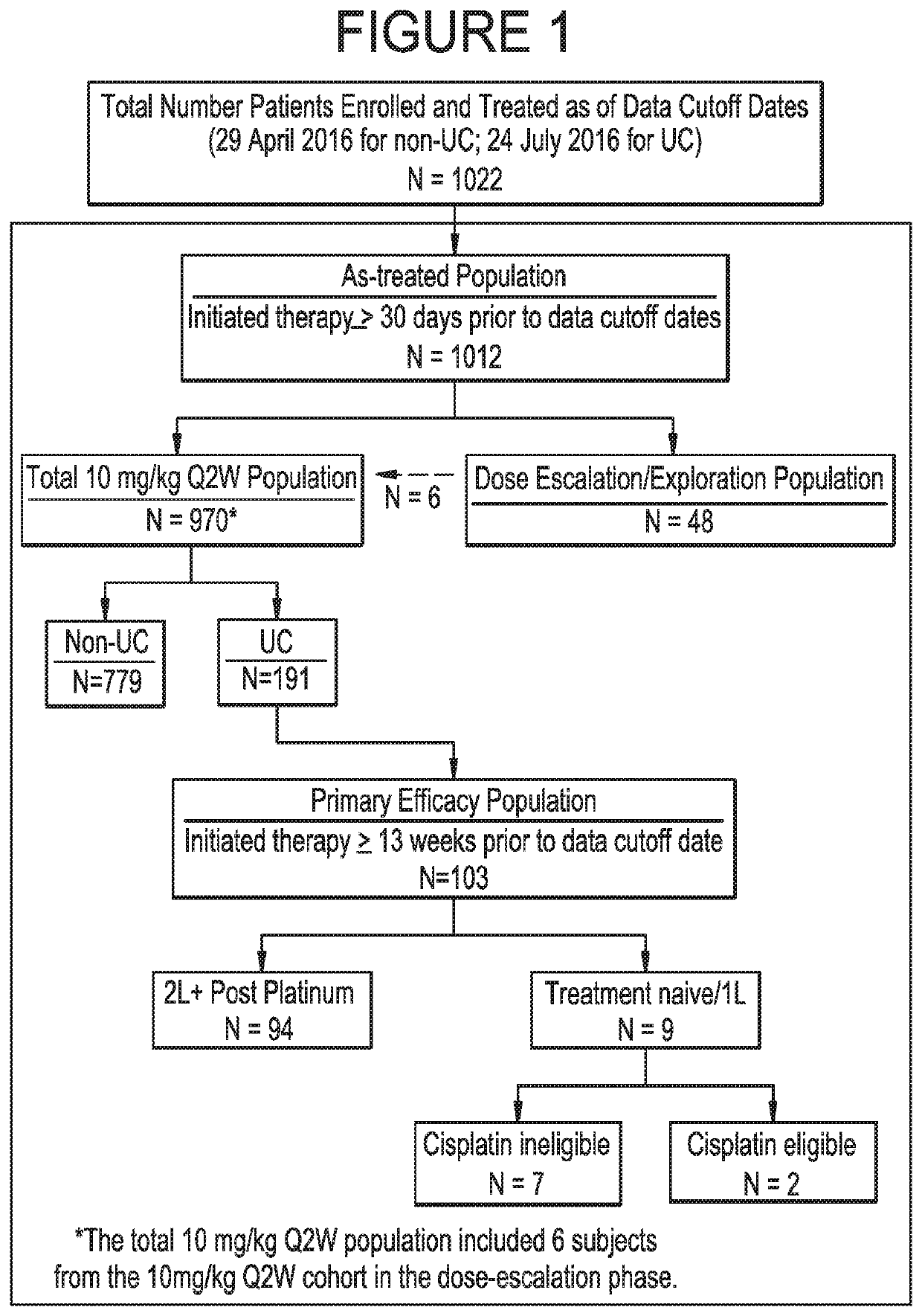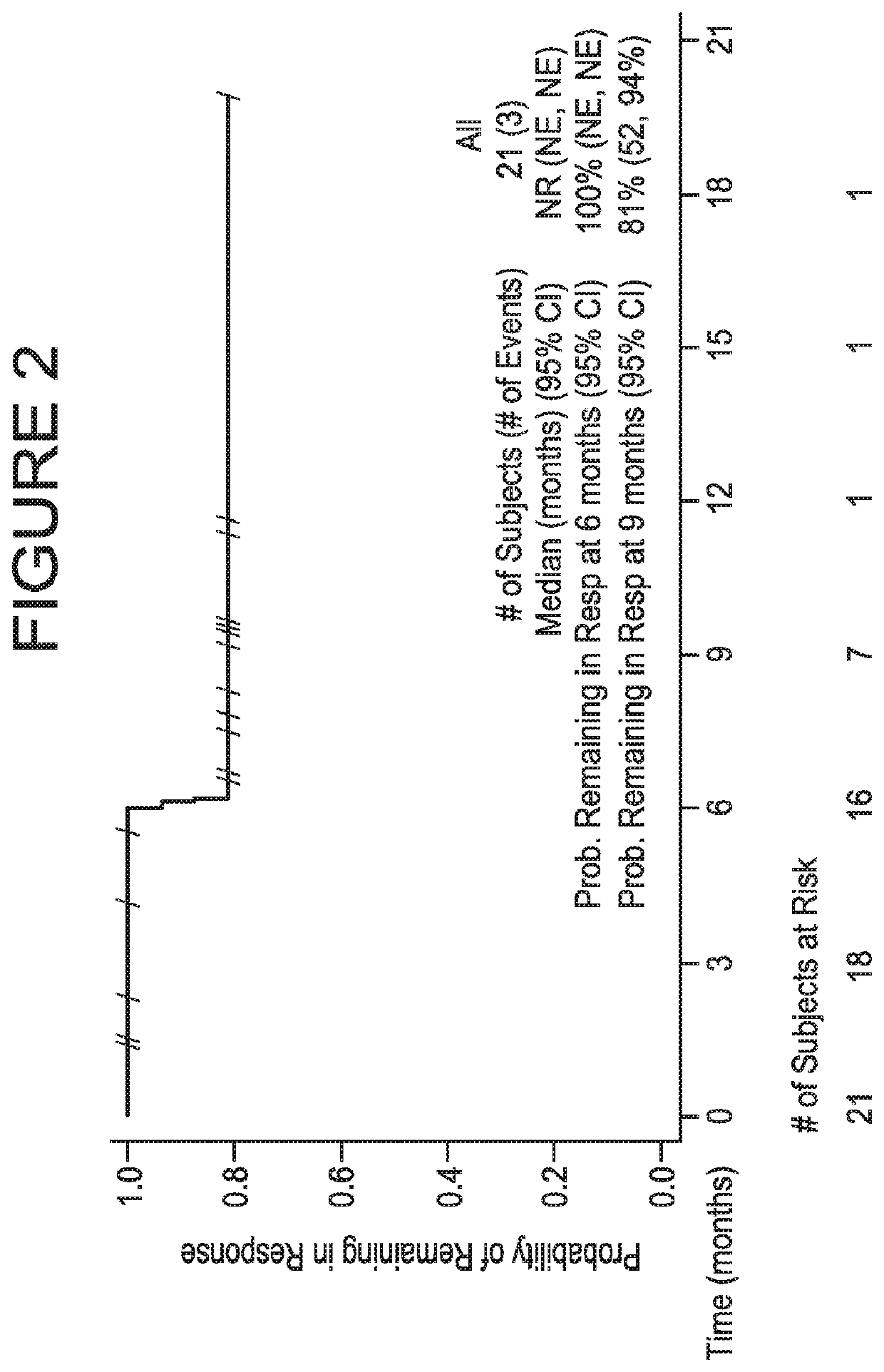Anti-pd-l1 antibody treatment of bladder cancer
a bladder cancer and anti-pdl1 technology, applied in the field of bladder cancer methods, can solve the problems of poor prognosis of patients with locally advanced or metastatic uc, and the relative 5 year survival rate of approximately 15%, and achieve the effects of reducing or low/neg high levels of pdl1 expression, and effective treatmen
- Summary
- Abstract
- Description
- Claims
- Application Information
AI Technical Summary
Benefits of technology
Problems solved by technology
Method used
Image
Examples
example 1
s of Durvalumab Based on Clinical Analyses
[0097]This Example provides an overview of the clinical pharmacology of durvalumab and demonstrates that this anti-PD-L1 antibody or an antigen binding fragment thereof exhibits properties and characteristics that support its suitability for use in the described methods of treating bladder cancer, such as urothelial carcinoma (UC), in a subject having bladder cancer, such as UC, and in need thereof.
A. Pharmacokinetics (PK) of Durvalumab
[0098]The pharmacokinetics (PK) of durvalumab was studied in 1,337 patients with solid tumors who received durvalumab at doses ranging from 0.1 to 10 mg / kg administered Q2W, or 15 mg / kg administered every 3 weeks (Q3W), or 20 mg / kg administered every 4 weeks (Q4W). Following durvalumab treatment at 10 mg / kg Q2W, PK was expected to be in the linear range and in line with typical monoclonal antibodies (mAbs). Key results of the PK analyses demonstrated the following:[0099]Durvalumab exhibited nonlinear PK at dos...
example 2
Trial Involving the Treatment of Subjects Having Bladder Cancer (UC) with Durvalumab
A. Overall Trial Design
[0114]The data related to the methods described herein are provided by ongoing Study 1108, a Phase 1 / 2, single-arm, open-label, multicenter clinical trial (ClinicalTrials.gov Identifier: NCT01693562). The dose-expansion phase of the Study included 17 different tumor-specific cohorts, including a urothelial bladder cancer (UC) cohort. Patients in the dose-expansion phase were treated and continue to be treated with durvalumab at 10 mg / kg Q2W.
[0115]A UC expansion cohort with no limitation on prior lines of therapy was initiated in which approximately 60 patients having histologically or cytologically confirmed UC were to be enrolled; the first 20 patients were enrolled regardless of PD-L1 expression, and the subsequent 40 patients were required to have ≥5% of their tumor cells positive for PD-L1 expression. Thereafter, 132 additional patients having histologically or cytologicall...
example 3
Combination of Durvalumab and Trememlimumab for Treating Bladder Cancer, e.g., UC
[0157]A confirmatory clinical trial (DANUBE) supports the clinical study described in Example 2 for the use of durvalumab in the treatment of UC. The supportive clinical study is a Phase 3 randomized, open-label, controlled, multicenter, global trial to determine the efficacy and safety of durvalumab monotherapy (1.5 g IV every 4 weeks (Q4W)); or durvalumab (1.5 g IV Q4W) in combination with tremelimumab (75 mg IV Q4W) for up to 4 doses / cycle each followed by durvalumab (1.5 g IV Q4W) versus Standard-of-Care (SoC): (cisplatin+gemcitabine or carboplatin+gemcitabine doublet, based on cisplatin eligibility) 1L chemotherapy. In this study, patients are treatment-naive with histologically or cytologically documented, unresectable, Stage IV transitional cell carcinoma (transitional cell and mixed transitional / non-transitional cell histologies) of the urothelium (including renal pelvis, ureters, urinary bladde...
PUM
| Property | Measurement | Unit |
|---|---|---|
| median time | aaaaa | aaaaa |
| time | aaaaa | aaaaa |
| concentration | aaaaa | aaaaa |
Abstract
Description
Claims
Application Information
 Login to View More
Login to View More - R&D
- Intellectual Property
- Life Sciences
- Materials
- Tech Scout
- Unparalleled Data Quality
- Higher Quality Content
- 60% Fewer Hallucinations
Browse by: Latest US Patents, China's latest patents, Technical Efficacy Thesaurus, Application Domain, Technology Topic, Popular Technical Reports.
© 2025 PatSnap. All rights reserved.Legal|Privacy policy|Modern Slavery Act Transparency Statement|Sitemap|About US| Contact US: help@patsnap.com



